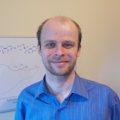Rafał Szabla, Ph.D.
Postdoctoral Research Fellow, Institute of Physics, Polish Academy of Sciences
Education: Masaryk University, Ph.D., Biomolecular Chemistryes
Institution: Institute of Physics, Polish Academy of Sciences (laboratory of Andrzej Sobolewski)
SCOL Project: Mechanistic Studies of Prebiotically Plausible Ultraviolet-Induced Chemistry
Solar radiation could have played a crucial role during early chemical evolution, owing to the postulated higher sun activity in the ultraviolet (UV) spectral region and the absence of the ozone layer on the early Earth. The remarkable photostability of biomolecular building blocks and the recently discovered intrinsic self-repair mechanisms of oligonucleotides can be considered molecular fossils and support this hypothesis. UV irradiation is also an important source of energy, which often selectively promotes chemical reactions that would not be feasible otherwise. In this context, thorough understanding of prebiotically plausible UV-induced processes might play a fundamental role in studies that aim to discover the origins of biomolecules on Earth. High-level quantum chemical calculations are among the most accurate tools that help to determine the fates of UV-excited molecules. They can serve as a ‘molecular microscope’ and enable observations of the critical events in the photoreactivity. Such theoretical studies can be conducted both by statically probing the multidimensional space of molecular coordinates responsible for a specific photoreaction, or dynamically by tracking the molecular changes on a femtosecond timescale. It is important to mention that theoretical investigations of photochemical processes require particular care in appropriate method choice. This is mainly caused by the very complex nature of the electronic wave function that describes photoexcited molecules. Quantum chemistry was proved to solve many photochemical problems that could not be addressed by conventional experimental techniques. Furthermore, sophisticated time-resolved ultrafast spectroscopic experiments greatly benefit from the support provided by quantum chemistry; for instance, in interpretation of the spectra. In this project, I will apply state-of-the-art quantum chemical methods in order to investigate the mechanisms of prebiotically plausible photoinduced reactions. In addition, I will study the intrinsic UV-induced self-repair mechanisms occurring in nucleic acid strands to answer the question of whether strong UV fluxes could have affected the preselection of DNA sequences. These theoretical investigations, performed in close collaboration with several experimental laboratories, could provide many fundamental insights into the role of UV irradiation during the early stages of abiogenesis.